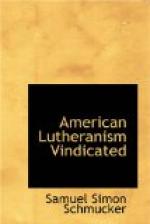(c) Dr. Baumgarten Crusius, Professor of Theology at Jena, in his History of Christian Doctrines, Vol. II. p. 322, thus testifies: “By means of the religiously energetic language of Luther, exorcism was introduced among his party, and established itself amid much opposition, (amongst others from the Papists) in rigid opposition to Calvinism, and as is the case amongst us at present, (1846,) from attachment to ancient, stern orthodoxy, and their idea of genuine Lutheranism, as well as from the superstitious belief of a magic influence over the kingdom of evil spirits.”—“The liturgic formula (for exorcism) retained in the Lutheran church, was first zealously espoused by the populace, when the Crypto-Calvinists especially in Saxony, raised opposition to it; and since then it has been regarded as a criterion of Lutheranism, although exorcism is not mentioned in the Saxon Articles of Visitation, and from an early period it was defended by the Lutheran theologians merely as a free matter of indifference, with only a figurative meaning.” Here we find not only that exorcism has extensively prevailed in the Lutheran church of Germany, but that as late as 1846, it still was adhered to by some in Saxony: and that for a long time after the rise of Crypto-Calvinism in the latter part of the sixteenth century, adherence to this rite was regarded as a test of genuine Lutheranism. How vain therefore the attempt to deny that it was regarded as a part of symbolic Lutheranism in some parts of the church!
(d.) Dr. Augusti, Professor of Theology at Bonn, and more recently at Berlin, the celebrated author of numerous works, bears the following testimony: “At the close of the sixteenth century the vindication of exorcism was considered a proof of Lutheran orthodoxy in opposition to the Reformed and Crypto-Calvinists. In the seventeenth and eighteenth centuries there was much contention for and against it; and even in the nineteenth century its retention or rejection was not yet regarded as a matter of indifference.” p. 350.
(e) In Siegel’s Manual of Christian Ecclesiastical Antiquities, (a learned and excellent work in four volumes, published in Leipsic, 1836,) vol II. p. 64, 65, 67, we find the following testimony: “Inasmuch as he (Luther) pronounced this rite not indeed as necessary, but yet as highly useful, in order to remind the people very impressively of the power of sin and the devil; it was not remarkable that the zealous adherents of Luther were also unwilling to abandon his views on this subject. Hence we find that in all countries in which the views and example of Luther were rigidly adhered to, as in Saxony, Wuertemburg, Hanover, Sweden, and other places, a strong attachment to exorcism prevailed, which was often regarded as the criterion of orthodoxy.” “Some Lutherans cherished exorcism with a kind of passionate fondness.” “In




